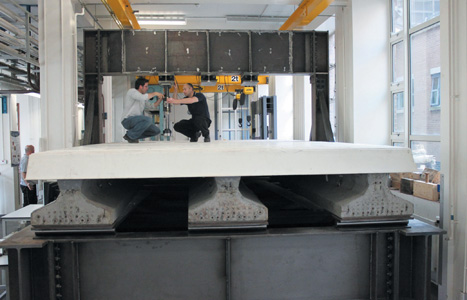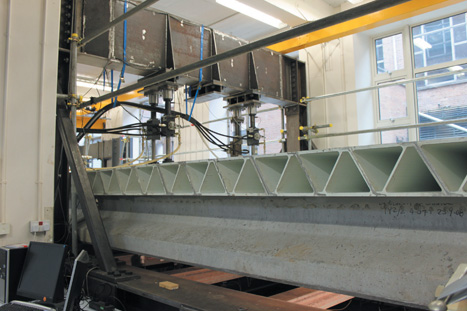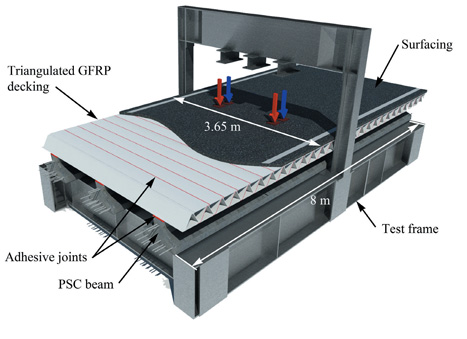The extensive use of advanced composite materials glass, or carbon-fibre-reinforced polymers could be the answer to building bridges in half the time, reducing costs during construction while potentially improving the structural reliability of the completed bridges.

Composites are stiff, strong, light, corrosion-resistant materials that have been used in the aerospace, automotive and yachting industries for decades. However, since they behave differently from traditional construction materials such as steel, concrete and timber, novel design approaches are needed to use them cost effectively in civil engineering applications.
Now, a research team led by Dr Wendel Sebastian, a senior lecturer in structural engineering at Bristol University’s Department of Civil Engineering, is pioneering ways to make it easier for civil engineers to use such composite decks in the construction of beam and slab road bridges.
“Ensuring the smooth flow of forces between the components through the joints is important”
According to Sebastian, bridges using advanced composites have already been built in countries such as the US, the UK and Spain. Some of these have been designed using composite decks with steel beams, while at least one uses concrete decking on composite beams. A few have even been constructed using both composite decking and composite beams.
The key advantages of bridges built with fibre composite materials over their more traditional steel and concrete counterparts is that they are lighter, they can be more rapidly constructed and they are potentially more durable.

As composites can reduce the self weights of bridges, the foundation costs can be significantly lower owing to the fact that the bridges do not have to carry as much of their own dead weight. What’s more, since the composite materials can be shaped into modular sections, they can be easily assembled on site.
According to Sebastian, evidence to date suggests composite bridges could be constructed in just a few weeks using light cranage, compared with the months and heavy cranage it can take to construct bridges using traditional materials and construction approaches.
In terms of durability, carbon or glass-fibre composite bridge decks can avoid corrosion, which affects steel decks or steel-reinforced concrete decks. In these examples, continued exposure to winter de-icing salts spread onto the surfaces of the bridges to maintain traffic safety can be an issue. When salt solution seeps into cracks in concrete bridge decks, it attacks the embedded steel reinforcement, causing it to swell, breaking up the concrete and deteriorating the deck.
While Sebastian admits that glass-fibre decks would need careful monitoring, they are highly resistant to the problem of corrosion a factor that could lead to reduced maintenance costs for the bridges in the long term.
Despite their advantages, it is still not common practice for civil engineers to use composites to build modern bridges. Sebastian believes one of the reasons for this is that structural design codes for advanced composite bridges are not widely available to make the detailing of such bridges readily accessible to practitioners.
’The resulting lack of such codes for composite bridges means that, each time a new form of composite bridge is built, the firm involved in building the bridge must perform proof testing of key details specific to that bridge form,’ he said.
However, to keep a competitive edge in the marketplace, bridge developers retain, rather than disseminate, the information detailing the technical characteristics of the bridge hence the engineering community is not in a position to benefit from their work.
Sebastian added that there is a limited amount of detailed information in the public domain concerning the properties of such structures. Much of the information provides engineers with the performance of reduced-scale laboratory models comprising composite decks spanning across one or two main beams.
This means structural action in the transverse direction owing to the continuity of the deck across multiple beams has not yet been comprehensively investigated. It also means the behaviour at full scale under properly quantified conditions is not yet well known.
To rectify this, part of the work at Bristol involves detailing and documenting the characteristics of a more comprehensive realistic model of a composite bridge.
To do so, Sebastian’s research team has built, and is testing, a prototype of a large-scale bridge with composite decking at the university’s structures lab. The 8m-long, 3.7m-wide model comprises a triangulated glass-fibre-reinforced polymer composite deck provided by Fiberline Composites of Denmark spanning across three pre-stressed concrete (PSC) main beams.
The PSC beams match the corrosion resistance of the decking and improve stiffness. One innovation is that only adhesive, rather than mechanical, connections have been used between the deck units and to connect the deck to the main beams, simplifying and speeding up construction.
An instrumentation system is helping to monitor the behaviour of the bridge under load, capturing details about the mechanical characteristics of the adhesive joints between deck units and between the deck and main beams.

’The integrity of a bridge can be strongly influenced by the joint characteristics, so the joints must be structurally robust,’ said Sebastian. ’So ensuring the smooth flow of forces between the components through the joints is of key importance. We expect that the instrumentation layout on our lab specimen coupled to our ongoing computer modelling of the structure will advance our understanding of the load paths through the joints and so provide a platform for reliable joint design or for improvement of the joint details.’
The prototype is being subjected to more than 100m cycles of full-scale lorry wheel loading. The large area of the deck will also allow the researchers to investigate the effects of different anti-skid surfaces on the performance of the deck. Finally, the model will be loaded to failure.
During the course of the tests, Sebastian hopes to learn more about the internal mechanisms by which composite bridges resist load. He said the work could generate ideas that underpin even more exciting and economical composite bridge designs.
The project is supported by the Highways Agency, the Institution of Civil Engineers, Network Rail, Mouchel, Tarmac and Weber. According to Sebastian, results from the testing will help the researchers to create design guidelines for the supporters of the project and for those in the wider civil engineering community who will take advantage of composites in the design of new bridges.




Red Bull makes hydrogen fuel cell play with AVL
Formula 1 is an anachronistic anomaly where its only cutting edge is in engine development. The rules prohibit any real innovation and there would be...